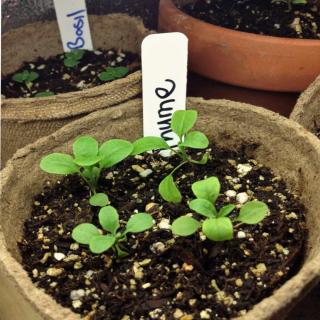

The garden season begins with indoor sowing at the end of Winter. It’s important to choose your equipment well and prepare ideal growing conditions to get strong seedlings for transplanting in the garden and in containers.
The main advantage of sowing indoors is to trigger germination and protect seedlings from the cold even as outdoor temperatures are still inhospitable.
With this technique, you’ll save time and get both blooms and harvest much earlier!
Easiest is to simply start your seeds in a tray or a shallow crate. In addition, it’s also possible to cover this with a mini-greenhouse for plants that require constant warmth. Nursery trays with pre-formed plug holes are very convenient and are great for saving both time and materials. Indeed, only a single seed is set per hole, and transplanting is a cinch. Small seed pots formed from peat or coconut fiber have a decisive advantage: you can plant them directly in the ground!
The substrate must be light and should drain very well. Special potting mixes are available, but you can also prepare your own. Blend normal potting soil together with river sand and you’re good to go.
Remember to first start with a layer of clay pebbles, gravel or perlite at the bottom to make sure your containers drain well.
Ah, perhaps the most important step! Write the variety and sowing date on labels. That way you don’t get things mixed up later on.
Whether you’re growing in a greenhouse, a lean-in, a veranda or simply on a windowsill, germination requires constant temperatures during the whole process. Depending on the plant, it may be enough to just keep frost and freezing away. For others, such as tomato, melon or most tropical plants, a 64°F to 75°F (18°C to 24°C) range is necessary.
There’s a balance to strike in providing constant moisture for your seedlings without drowning them or they’ll rot and suffer from damping off!
Indoor sowing is usually started at the end of winter or very beginning of spring for most vegetable plants like tomato, the Cucurbitaceae family, chili and eggplant. Most tender ornamental flowers benefit from indoor sowing at that time as well, such as zinnia, carnation, cosmos…
Perennial plants like yarrow, beeblossom, tickseed and heuchera start off best when started indoors as early as February. By the time Fall comes, they’re strong enough for planting in the garden.
Biennial plants, for instance pansy, wallflower, and many more, should actually be planted inside at the end of summer or early fall. Spending winter under shelter makes them ready for transplant in the following Spring.

Remember to keep your seedlings in a place where the air isn’t too dry.
Sprinkle grated wood coal powder in the mix to prevent most fungal diseases such as damping.
Written together with Hydrozone.fr, light edits by Gaspard